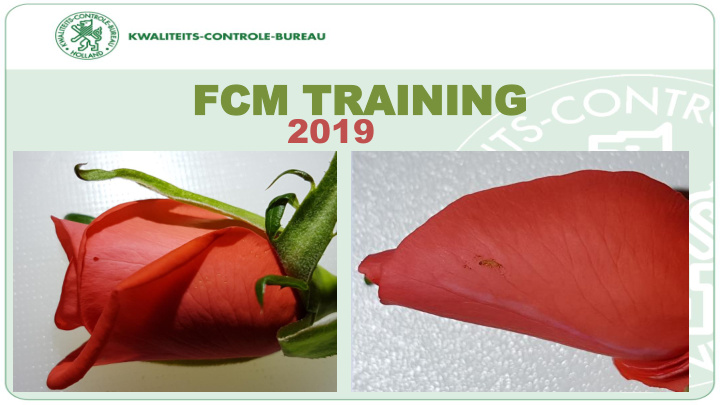



FCM FCM TRAINING TRAINING 2019 2019 2019
2 My name: Kees van der Vijver Regional phytosanitary specialist Amsterdam Airport/ Flower auction FloraHolland First line inspector
3 The purpose of my presentation: To tell something about import inspections How do you recognize damage caused by caterpillars What are the main characteristic differences between the Helicoverpa and Thaumatotibia (FCM) caterpillars/ eggs To practice with the participants the Quiz “who am I ?”
5
6
7 Specifications recognized phytosanitary import inspection post Inspection table – smooth and clean surface of at least 1 m2 Sufficient light over the entire table – at least 60 lux or led light between 3000 – 5000 k The light source about 1 meter above the inspection table
8 Sample size import inspection cutflowers per shipment Number of stems per genus number of stems to inspect < 400 50% 400 – 10.000 200 stems 10.001 – 25.000 300 stems 25.001 – 40.000 400 stems 40.001 – 55.000 500 stems 55.001 – 70.000 600 stems 70.001 – 85.000 700 stems 85.001 – 100.000 800 stems 100.001 – 125.000 900 stems 125.001 – 150.000 1000 stems 150.001 – 200.000 1100 stems > 200.000 1200 stems Samples for at least out of 2 boxes. A maximum of 200 stems per box
Damage caterpillar
10 Egg + damage caused by FCM
11
Caterpillars Noctuidae mostly found eating on the outer petals Caterpillar Thaumatotibia eating from the outside of the rosebud towards the stamens
16
18
19
Noctuidae (including Helicoverpa a. ) Tortricidae ( includingThaumatotibia l.) Crochets in a row Crochets in a complete circle 11
Noctuidae Tortricidae 2 Lateral- setae on Thorax1 3 Lateral setae on Thorax1 L1, L2 and L3 L1 and L2
Helicoverpa fam.Noctuidae Thaumatotibia subfam.Olethreutinae A9 22 A9 Pinaculum with 1 setae (hair) A9 Pinaculum with 2 setae (2 hairs)
23 Helicoverpa Thaumatotibia (FCM) The younger caterpillars: The younger caterpillars: Orange in color, the head and thorax shield Color is somewhat white, both the head and are brown. thorax shield are dark brown
Helicoverpa Thaumatotibia The skin is covered with clear visible sharp spines/ short spines are closer to each other than Helicoverpa thorns
25 Different stages Thaumatotibia leucotreta (FCM)
26 First instar dorsal lateral view Larvae of Helicoverpa armigera Second instar dorsal lateral view Third instar dorsal Lateral view Fourth instar dorsal Lateral view
Spodoptera frugiperda - Noctuidae ( an increasing number of interceptions) Pinacula on A8 in a square Ringed pinaculum SD1 Pinacula on A9 like a trapezium Info: idtools.org/id/leps/lepintercept
Eggs….
Eggs Helicoverpa Thaumatotibia The egg is laid seperately and is quite flat. The egg looks like a fried egg Egg is laid separate on the outside of rosebud. The egg has ribs and on top there is Bump.
Eggs Spodoptera sp. Eggs always placed in egg packages covered with hair
Flowchart caterpillars most found in Roses Kenya Crochets in a complete circle A9 : 2 setae (hairs) on D + SD pinaculum Thaumatotibia leucotreta (FCM) = Q EU A9: Lateral pinaculum 3 L setae Thorax 1 : L1 + L2 + L3 4 pair prolegs Helicoverpa Skin covered with sharp spines Crochets in a row No Q A9: 1 setae D + SD Noctuidae Pinaculum Spodoptera littoralis No spines, dark spots on T1 Thorax1 : L1 + L2 = Q EU No spines, A8 pinacula in a square, A9 in a trapezium Spodoptera frugiperda = Q EU Info: idtools.org/id/leps/lepintercept Q = Quarantine organism
33 The Quiz: Who am I ?
34
35
36
37
38
39
40
41
42
43 Thank you for your attention!
Recommend
More recommend